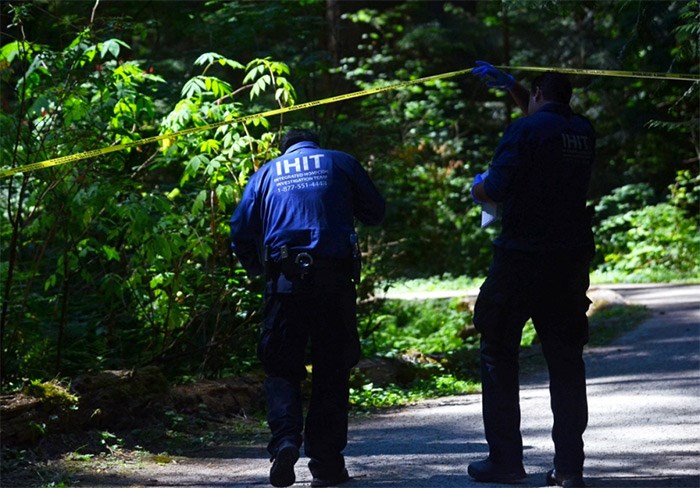 Homicide investigators search for evidence at Burnaby’s Central Park in July after the death of a 13-year-old girl. Photograph By CORNELIA NAYLOR
Homicide investigators search for evidence at Burnaby’s Central Park in July after the death of a 13-year-old girl. Photograph By CORNELIA NAYLOR
Three months after the body of 13-year-old Marrisa Shen was found in Burnaby’s Central Park, the city has adopted a handful of measures to make parks and public places safer.
At Monday night’s council meeting, city council approved – in principal – six safety tools, including bike patrols.
The unit would be made up of bylaw enforcement officers in uniform. Staff are recommending the city launch the group as a one-year pilot project, with coverage in Central Park, Robert Burnaby Park and Burnaby Lake Park. (A quarter of Burnaby is made up of green space and parks.)
Coun. Pietro Calendino, chair of the city’s public safety committee, told the NOW bike patrols will be “most effective.”
“You see a person in uniform on a bike who can go faster than you, and you’re careful with what you’re doing,” he said.
The City of Burnaby is also looking at installing security cameras at key access points in Central Park.
“Recorded footage of these cameras will be used to provide law enforcement and investigators with a greater ability to gather potential evidence in the event that illegal activities take place within the park,” reads a staff report.
The city currently monitors other outdoor areas such as frequent illegal dump sites and common areas in rec centres.
Putting in a few call boxes is also being considered for Central Park. They’d be installed on a trial basis “to gauge their effectiveness and usefulness,” according to the report, and would be located at “heavily used locations.” They would provide a direct contact to 911 dispatch.
“It’ll have GPS that locates exactly where they are so if the patrol person or the RCMP have to go, they know exactly where their location is. That’s a good thing,” said Calendino.
Another deterrent on the city’s radar is a park closure bylaw. The bylaw would need to go through public consultations to identify certain parks and what specific areas should be closed at night.
City staff will also review park signage to make sure it’s clear, visible and informative. New information kiosks were recently installed at Central Park at five key access points, notes the report. The goal is to expand this signage into the park’s interior and at other major parks in the future.
Enhanced lighting at major trail heads is also being recommended. The report notes lighting remote areas can create a false sense of security, but when used properly, illuminating areas that are monitored by residents or drivers can make those places safer.
Asked if the safety measures are in response to Shen’s death, Calendino said staff have been working on the file for a number of years.
“They had already done a lot of work; they just put it together (faster),” he said.
At Monday’s meeting, Mayor Derek Corrigan said despite these additional safety tools, people still need to be cautious and use their common sense.
“I do not want anyone to think that this means you should go into isolated areas in parks alone, or that you should be in, after dark, in our parks. That is not what we are suggesting,” he said. “This is a very difficult problem for anybody to be able to sort through and I think this is an elegant set of solutions, that it does as much as it can. It does not solve the problem, because the reality is that isolated places, particularly at night, can be dangerous.”
A report outlining cost, equipment requirements and locations will come before council at a later date.
Shen’s body was found on July 19. Video footage shows Shen on the south side of Central Boulevard, walking west and crossing McKay Avenue at 7:38 p.m. the night before. Police believe her death was a random homicide. No one has been arrested for the crime.


